Leszno 2025-05-14
Railway line No. 14 Łódź Kaliska – Tuplice.
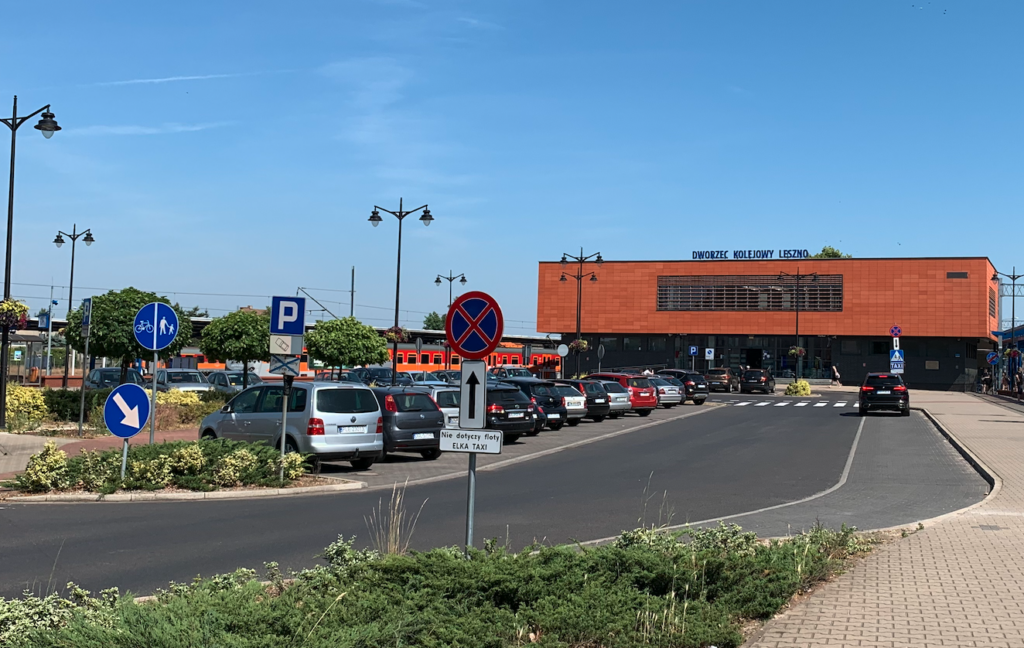
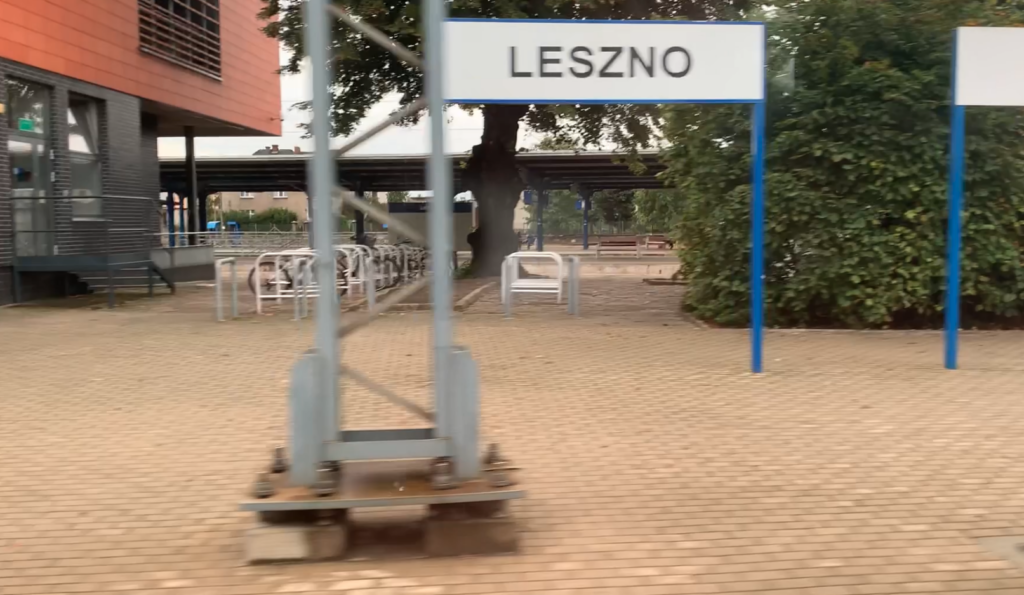
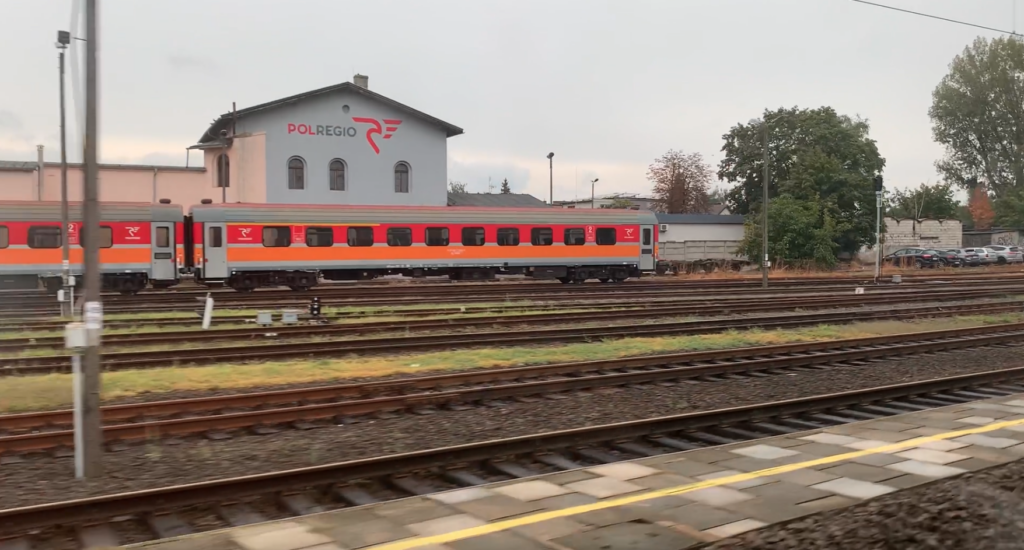
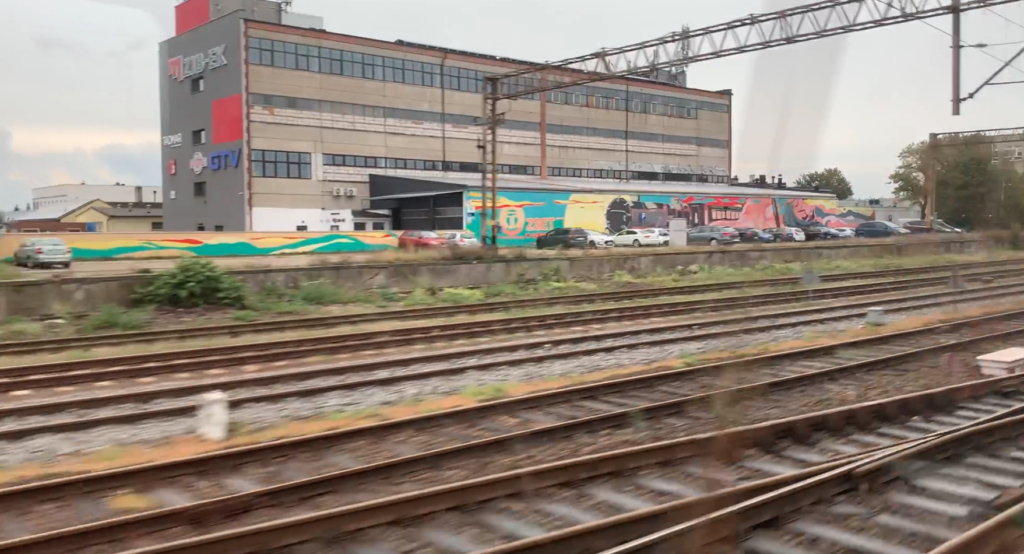
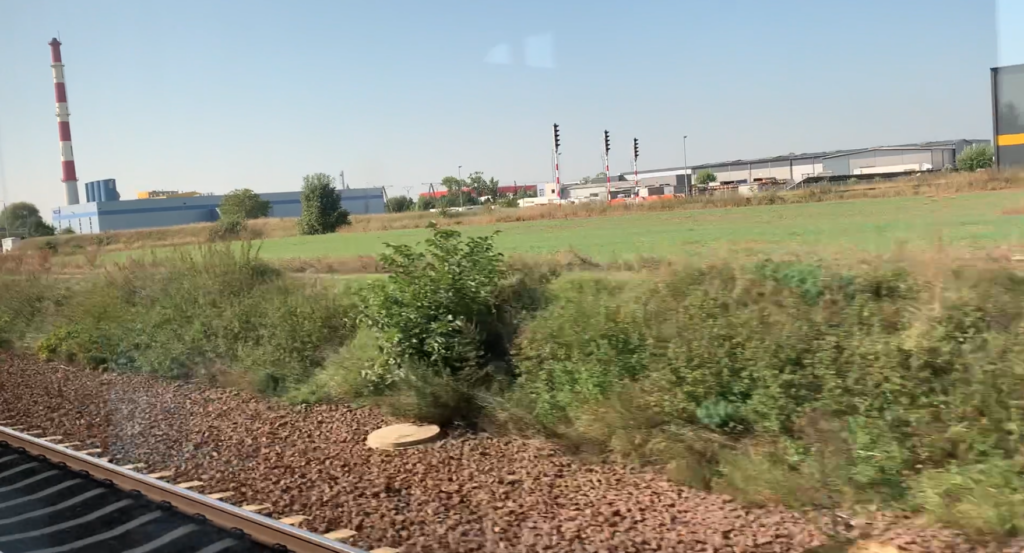
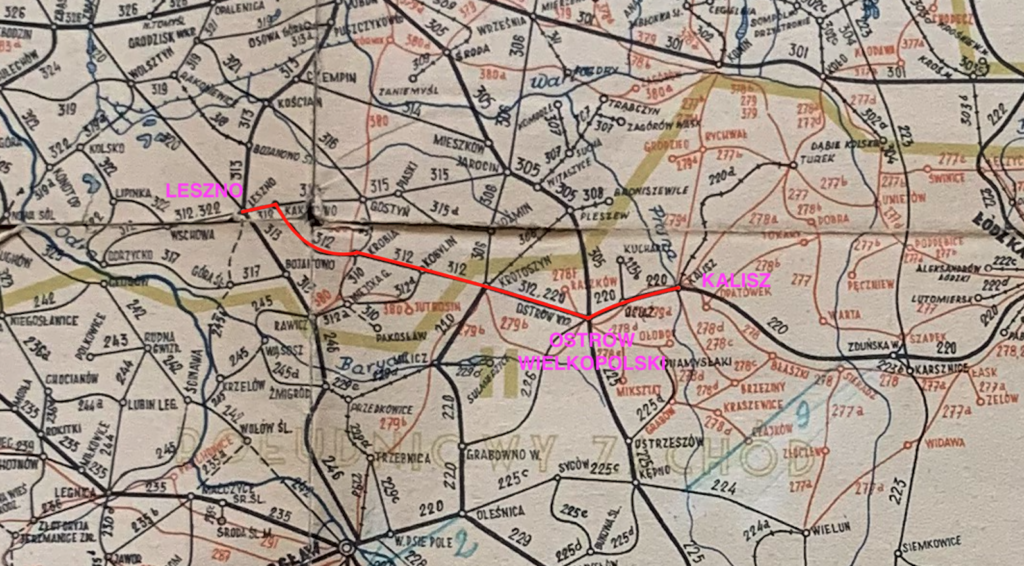
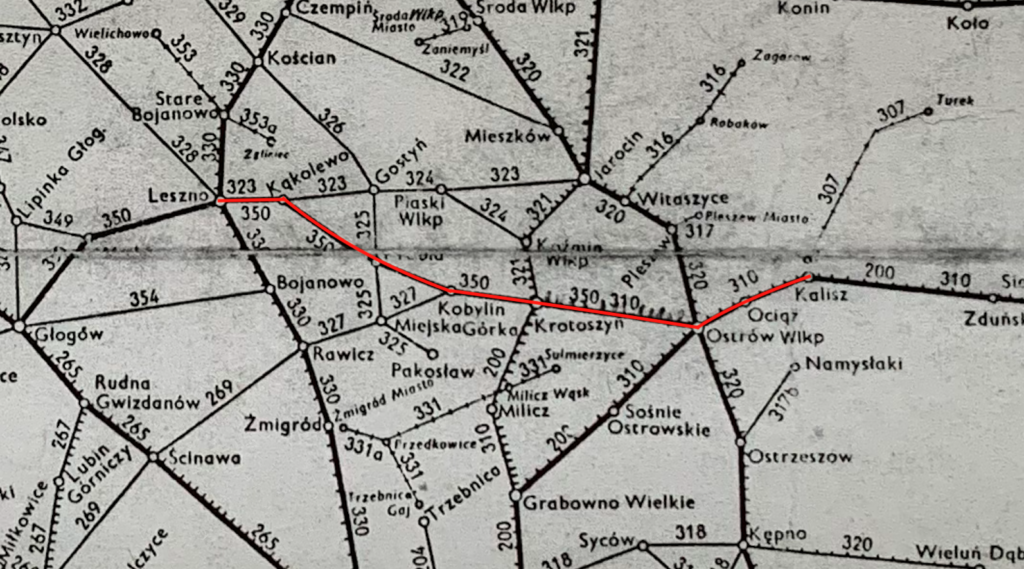
Railway line No. 14 Łódź Kaliska – Tuplice runs latitudinally, from east to west. The line is 388.578 km long, partly double-track, partly electrified with 3 kV DC current. The maximum speed is 120 km/h. Currently, the gauge is 1,435 mm. The line historically consists of several sections built in different periods, by different companies, in different track gauges and for other reasons. Individual sections were built in the period 1846-1915. Electrification took place in the period 1965-1981. Currently (2025), only some sections are important for the national economy. The railway line is equipped with the SHP system along its entire length. Line No. 14 belongs to freight corridor No. 8.
Freight corridor No. 8.
Railway freight corridors are a European undertaking aimed at increasing the attractiveness of rail transport compared to other types of transport. The obligation to implement them was imposed on Poland by Regulation (EU) No. 913/2010 of the European Parliament and of the Council of 22 September 2010 on a European rail network for competitive freight transport. In reality, it is the imposition of the European Union agenda on the member states according to Berlin’s will. Even a 500 km long route, running through two countries, can be subordinated to Berlin’s decisions. Corridors No. 5, 8 and 11 have been imposed on Polish railways. RFC Corridor No. 8 – North Sea – Baltic Sea; leading from Belgium and the Netherlands through Germany, Poland, Lithuania, Latvia to Tallinn in Estonia. The corridor was created on January 1, 2013. In this case, an analogy to the situation before World War II comes to mind; another point of depriving Poland of sovereignty. EU funds go to beneficiaries for specific investments, which Berlin designates. Among them is the project of corridor No. 8.
CPK Program.
Let us remember that during the United Right Government (2015-2023), the Central Communication Port (CPK) program was created. A system of so-called Railway Spokes was developed so that 90% of Polish residents could reach the Central International Airport within two hours. One of the sections of spoke No. 9 was to be the section; Zielona Góra – Głogów – Leszno – Kalisz. This line was to be modernized and adapted to a speed of 200 km/h. Unfortunately, after the change of government, the CPK Program was liquidated.
Warsaw – Kalisz – Skalmierzyce.
The Ostrów Wielkopolski – Leszno – Głogów – Tuplice railway line is currently a section of railway line No. 14. The line was built in the Prussian partition in the 19th century and played an important role in trade between brothers; Muscovites and Prussians. On the Muscovite side was the Warsaw-Kalisz Railway (1902), which we discussed in detail in the chapter: Warsaw-Kalisz Railway. 1902.
The Warsaw-Kalisz Railway was the first in the Kingdom of Poland, i.e. in the Moscow Partition, which led westwards, directly towards the Prussians. The line was put into operation only in 1902, i.e. 54 years after the construction of the Warsaw-Vienna Railway. The line was built on the initiative of the Warsaw-Vienna Railway Joint-Stock Company. Under pressure from the Muscovites, the line was built in the Moscow gauge, i.e. 1524 mm. The Warsaw-Kalisz Railway (Варшавско-Калишская железная дорога) is a line that connects Warsaw with Kalisz. Construction lasted from 1900 to 1902. The line was launched on November 15, 1902.
In 1862, the Prussian Railway Construction Committee was established, with the intention of building a Wrocław-Warsaw railway line. The railway was to run along the route; Wrocław-Kobylin-Krotoszyn-Ostrów-border between brothers-Kalisz-Opatówek-Sieradz-Zduńska Wola-Pabianice-Łódź-to connect with the Warsaw-Vienna Railway. A relevant letter was sent to the Muscovites, but the request went to waste. There were several other attempts to build a similar connection, but without results.
In 1898, the Ministry of Communication received two more requests for the construction of the Łódź-Kalisz line, this time from the Muscovites. The first was submitted by the Moscow Department of Commerce K.G. Schen, and the second by Lieutenant Colonel of the General Staff Tizenhauzen. After a few weeks, both entities submitted a joint application, which was already more detailed. It was proposed to rebuild the Warsaw junction to a wide gauge, build a branch to Koluszki and run a new Warsaw-Kalisz line. A similar application was submitted by the Board of the Ivanogródzko-Dabrowska Railway Society. The letters began to circulate faster.
It was decided to check whether the Warsaw-Vienna Railway Society could undertake the construction of such a line. On March 8, 1898, an extraordinary meeting of the shareholders of the Warsaw-Vienna Railway Society was held. It was resolved that the Society would apply for a concession to build and operate a line from Warsaw to Kalisz, with a link to the Prussian border. In July 1898, an application was submitted for field research. As it turned out, similar research was to be carried out by Lieutenant Colonel of the General Staff Tizenhauzen.
By the decree of 24 July 1898, the Tsar allowed studies to be conducted and preliminary technical designs to be developed, with the proviso that they should take into account two possible routes of the line. The first route: Kalisz – Sieradz – Łask – Łódź – Łowicz – Sochaczew – Błonie – Warsaw. The second route: Kalisz – Łęczyca – Pniewo – Sochaczew – Błonie – Warsaw.
The Tsar established that the takeover of the railway lines would take place after a maximum of 30 years and the line was to be already depreciated. These conditions were difficult and could only be met by the Warsaw-Vienna Railway Company. On 28 November 1898, the Railway Committee in St. Petersburg approved the concession for the construction of the line and in a gauge of 1524 mm. Additionally, the transport capacity of military transports was to be according to the standards adopted on the Moscow Railways. Military transports had priority over the transport of goods and passengers. The Tsarist authorities reserved supervision over the construction of the line and control of the work. The above conditions were recorded in the Tsarist decree of 14 April 1900, which confirmed the concession for construction.
The construction of a 1524 mm wide line was no problem for the Warsaw-Vienna Railway Company. The problem was the lack of rolling stock. Supervision of the construction of the line was entrusted to the Russian engineer Lipin. They also wanted to impose a chief construction engineer, to which the Society strongly protested. Ultimately, a rotten compromise was reached. The construction manager was the Muscovite engineer B.N. Kazin, and his deputy was the Society’s candidate, engineer Józef Prüffer.
At that time, the Warsaw-Vienna Railway Company office was located in Warsaw at the Evangelical Square (currently Małachowski Square). It was headed by Baron Leopold Kronenberg Jr.
The line was marked out through: Warsaw – Łódź – Kalisz – Skalmierzyce. Length 247 versts. A verst is an old Russian unit of length, equal to 1066.79 meters, in force since 1835.
Unexpectedly, the Germans refused a direct connection with the Prussian railways, the route was shortened to Kalisz. That is, the length was 236 versts. The total length of the tracks was to be 324 versts. The principle was adopted that the line was to pass without collision over other tracks and roads. Therefore, it was calculated that embankments would be on the length of 80% of the route. The aim was to guarantee unhindered transport of echelons. In reality, embankments were built on the length of about 20% of the line and many road crossings were built at the level of the tracks. In total, 174 bridges and culverts, 17 crossings and viaducts, one tunnel and 11 railway stations were built on the distance Warsaw – Kalisz. The Warsaw-Kalisz Railway Line crossed 3 governorates and 9 counties.
The planned construction cost was 19,450,542 rubles. In reality, the construction cost 21,931,600 rubles. The increase in costs was associated with the purchase of land, where corruption was rampant, and most of the money went to the commissioners. New technical solutions, steel rails, new rail fastenings to the sleepers were used during the construction. For the first time, 15 m long rails weighing 480 kg were used. For the first time, double sleepers and rail fastening elements two sleepers wide were laid under the rail joints. Most of the solutions were developed by engineer Aleksander Wasiutyński.
The first train, No. 1, from Warsaw to Kalisz departed on November 15, 1902, at 8:00, consisting of seven carriages. One more carriage was added in Zduńska Wola. The journey took 10 hours. The train arrived in Kalisz at around 18:00, welcomed by around 5,000 residents and a fire brigade orchestra. Train No. 2 from Kalisz to Warsaw also departed at 8:00, the same day.
Construction of the railway in Prussia.
In the 19th century, the organization of work in Prussia was closely linked to the economic and social changes resulting from the industrial revolution, agrarian reforms, and the development of the Prussian state as a strong bureaucratic monarchy. At the beginning of the 19th century (1807–1816), the Stein-Hardenberg reforms were introduced, which abolished serfdom and allowed peasants to acquire land for themselves. But the peasants had no financial resources, so banks came to the rescue, providing loans at high interest (usury). As a result, a significant number of landless rural workers were created, who were called farmhands. Only a small class of independent peasants, farmers, emerged. Many peasants and rural workers took on seasonal work on landed estates, often on a contract basis. From the mid-19th century, especially after 1850, the development of industry intensified; mainly mining, metallurgy and the textile industry. Large industrial plants were established, where work was organized in a hierarchical manner, with division into management and workers. In industrial plants, strict work regulations were in force, there were penalties for lateness, and the workday lasted 12–14 hours. The rural poor moved to cities in search of work, which contributed to the emergence of a proletariat class. As a result, an excellent ground was created for the development of communism. Let us also remember that in Prussia there was no attachment to religion, because since the Reformation, confusion had been created in the minds of the lower social classes. Workers often worked in difficult conditions, without social protection. In factories, women and children worked equally with men. In the first half of the 19th century, workers were deprived of the right to organize, to strike or to negotiate working conditions. The Prussian authorities feared the radicalization of the working class, which is why they used various forms of supervision and repression.
The Prussian monarchy was an absolute and bureaucratic monarchy. Work in the administration was highly hierarchical, based on loyalty to the state and official discipline. Compulsory schooling was introduced and vocational schools were developed, which was to prepare young people for work in industry or administration. It was not until the end of the 19th century that the social situation of workers began to improve. Social insurance was introduced: sickness insurance (1883), accident insurance (1884), retirement insurance (1889). This was to counteract the radicalization of the labor movement and strengthen loyalty to the state, or rather the administration. Let us remember that social insurance was only applicable to workers working on the basis of a written contract, which was concluded only after a minimum of 5 years of work.
The work of Prussian workers on construction sites in the 19th century was hard, poorly paid and without social protection, but also crucial for the development of urbanization and infrastructure in Prussia. Construction work was usually seasonal, performed from spring to autumn. In winter, there was often no employment. The work included the construction of houses, factories, bridges, roads, railways and canals. The development of railways was particularly intensive, dating from the 1840s. Most of the work was done by hand, with the help of shovels, pickaxes and hammers. Wheelbarrows were mainly used for transport. Construction machines such as cranes, concrete mixers, and saws were rare. Workers were organized into work groups (brigades) supervised by a master (foreman). Many workers had no vocational education and this was a workforce from the poorest social classes, often from rural areas or from the Moscow and Austrian partitions. Contracts were oral or short-term, and payments often depended on the completion of the task. Construction workers’ earnings were low and employment was uncertain. There was no assistance in the event of illness or accident. Work lasted 12-14 hours a day, from dawn to dusk, with only one day off, Sunday. Workers often lived in barracks, without toilets or clean water. Diseases often developed, often contagious. There were no health and safety regulations, no gloves, no helmets, the scaffolding was temporary, and accidents were very common. The injured and sick often lost the opportunity to continue working and did not receive any benefits. Construction workers were a low social class, deprived of respect and even the opportunity to practice their faith. Workers were considered unskilled. It was not until the end of the 19th century that trade unions and craft associations began to be formed, which fought for the improvement of working conditions.
Testimony of a Prussian worker from 1880 – “We get up before dawn and eat bread and drink black coffee. We walk to the construction site, over two kilometers. Work begins as soon as we can see something. Stone by stone, brick by brick. Hands refuse to obey. There are no breaks in work. Talking to the foreman is punishable by punishment or dismissal. There were financial penalties for offenses. When there were delays in work, you had to go to work on Sundays. It was the hardest to work in the rain, because there was no downtime.”
Compared to England and France, Prussia was worse. The day was longer; 12-14. Social security was not introduced until the end of the 19th century. There were no trade unions, and the concept of a strike did not exist. Until the end of the 19th century, Germans did not understand that a skilled worker was valuable.
Railway lines in Prussia were built quickly and in large numbers, but of poor quality. Iron rails, 12 m long, were often used. Wooden pine and spruce sleepers were used, which were not impregnated. No metal sleepers were provided under the rails and the rails were attached only with nails. Gravel was used as a sleeper, and very rarely crushed stone, of an appropriate grade. The lines were marked out in long straight sections, from city to city. The lines had to be approved personally by the king, because he was a great supporter of them. It was not until the end of the 19th century that local communities joined in the construction of the lines, building very winding lines, but connecting workplaces, factories and warehouses in a given area. They were also built at a low cost and often required renovation. The advantage of these lines was the same European gauge, which allowed any wagon to enter.
On the Prussian side. Ostrów Wielkopolski – Tuplice.
The first section built in Prussian territory was the Głogów–Żagań section, which was launched on 1 October 1846 by the Niederschlesische Zweigbahn (Lower Silesian Branch Railway). On 30 December 1857, the Breslau-Posen-Glogauer Eisenbahn (Wrocław-Poznań-Głogowska Railway) opened the Leszno–Grodziec Mały section. On 18 May 1858, an extension of this line to Głogów with a bridge over the Oder was opened. On 31 December 1871, the Niederschlesisch-Märkische Eisenbahn (Lower Silesian-Marchian Railway) opened the Żagań–Żary section. On 30 June 1872, the Halle – Sorau – Gubener Eisenbahn (Hallsko – Żarsko – Gubinska Railway) extended the line to Żary, with the Cottbus – Forst line managed by them. On 1 October 1888, the Leszno – Ostrów Wielkopolski section was opened as a Prussian state railway. On 14 February 1896, its extension to Skalmierzyce was opened, on the then Prussian-Muscovite border. In 1902, full border traffic was opened.
On the Prussian side, a large station with a representative station was built; Skalmierzyce, and currently Nowe Skalmierzyce. The distance between the Skalmierzyce – Ostrów Wielkopolski stations is 18 km. The line ran from the Ostrów Wielkopolski station along today’s Osadnicza and Torowa streets. Additionally, along Melchiora Wańkowicza Street, there are current railway sidings to factories and wholesalers. In the area of Czekanów station, the line already ran along its current route. Because the line laid in this way hindered the development of the eastern part of the city, a new line was built. From Czekanów station, the line was led more northward. Then it runs under the Ostrów Wielkopolski – Pleszew line viaduct and on its western side reaches Ostrów Wielkopolski station. This reconstruction took place in the period 1940-1943, i.e. during the Second World War, which was started by the Germans and the Muscovites.
Also during the Second World War, the Germans began to rebuild the Leszno junction. From the Ostrów Wielkopolski side, the railway line entered the station on the eastern side. A railway viaduct was built over the Leszno – Poznań line and now the line from Ostrów Wielkopolski enters the stations in Leszno from the western side. At the same time, a connecting line was built; Leszno Ls8 – Marysiewice. The connecting line allowed trains to be redirected from the west (Wolsztyn) to the east (Krotoszyn) bypassing the Leszno station. Currently (2025), this connecting line is not in use and is partially dismantled.
A similar solution was built in the Krotoszyn junction. A connecting line was built: Osusz – Durzyn, bypassing the Krotoszyn station. For the belligerent Germans, this was a significant acceleration of military transports to the eastern front. Currently (2025), this connecting line is used for freight train traffic.
On LK No. 14 the second track was launched: In 1916, Łódź Kaliska – Ostrów Wielkopolski. In 1943, Ostrów Wielkopolski – Leszno. In 1888, Kąkolewo – Leszno. In 1901, Leszno – Żagań – Żary – Sieniawa Żarska.
Kalisz Szczypiorno – Ostrów Wielkopolski – Krotoszyn – Leszno.
Kalisz Szczypiorno was a border station during the partitions (115.64 km, elevation 138 m). Currently, it is a passenger stop. The border between the partitions ran at 117.91 km.
Nowe Skalmierzyce station (118.64 km, elevation 139 m). The line then runs under DK No. 25. Śliwniki is a non-existent loading bay (120.01 km, elevation 133 m). Ociąż was a junction station (123.78 km, elevation 137 m). Railway line No. 391 ran from the station, northwards to the towns of Kucharki and Głuski. The line was dismantled. Currently, there is a passenger stop in Ociąż. In Ociąż, there is a “Correct” factory operating in the mattress production sector. Czekanów station (129.07 km, elevation 133 m). Then the S11 motorway runs over the line. Next is the Stary Staw branch post (132.27 km, elevation 135 m), connecting road No. 811, towards Jarocin. The line crosses the Ołoboku river.
Ostrów Wielkopolski station (136.12 km, elevation 135 m). Railway lines No. 14, 272, 355. Ostrów Wielkopolski has railway exits in five directions. All lines are electrified and double-track. Only the line towards Oleśnica and further to Wrocław is single-track.
On September 7, 1973, the first electric train Kluczbork – Ostrów Wielkopolski entered track 1 at Platform 1, in Ostrów Wielkopolski. In this way, the section was officially put into operation. The ceremony was connected with the Railwayman’s Day. The train was the EZT ED70, which was called the opener, because it was the first to enter the electrified routes. At that time, there were boards at the station with the inscription Ostrów Wkp., in accordance with the spelling at that time. Currently, the abbreviation Wlkp. is acceptable. The locomotive shed was adapted to handle electric vehicles. Based on the Resolution of the Council of Ministers No. 45/74 of February 8, 1974, in October 1974, the first stage of electrification of the Oleśnica – Sieradz line was initiated on the Sieradz – Ostrów Wielkopolski section. The entire Oleśnica – Ostrów Wielkopolski – Sieradz section was put into operation on December 29, 1975. As a result, the shortest route was electrified; Warsaw – Wrocław. On this route, the ODRA Expresses appeared, which at that time were luxury trains, and the travel time was shortened. Currently, the “Wagon” factory, founded in 1920, and the Ostrów Wielkopolski Forge operate in Ostrów. Both plants work for the railway.
Ostrów Wielkopolski Zachodni (138.58 km, elevation 136 m). After leaving Ostrów Wielkopolski station from the south, the line turns west. Ostrów Wielkopolski Górzyce passenger stop (142.16 km, elevation 144 m). The line passes the forest. Łąkocin passenger stop (146.50 km, elevation 150 m). Next is the rail-road crossing DK No. 36, Krotoszyńska Street. Daniszyn passenger stop (150.45 km, elevation 130 m). The stop is located in the middle of the forest. Biadki station (153.88 km, elevation 136 m). Next, the line runs among cultivated fields. Gorzupia passenger stop (158.60 km, elevation 132 m). Next, the line crosses the Czarna Woda river. Durzyn passing point and branch post (162.44 km, elevation 138 m). This is where the Krotoszyn station bypass begins, No. 815.
In 2016, renovation began on the 105-124 km section, which consisted of replacing the rails with contactless ones. On this section Kalisz Winiary – Ociąż, the speed increased to 90 km/h. The section to Krotoszyn was supposed to be renovated in 2014, but lack of funds postponed the task for subsequent years. The entire Ostrów Wielkopolski – Głogów section was still on the reserve list for renovation. The electrification of the Krotoszyn – Głogów section was still being considered. A feasibility study was carried out at the time.
Krotoszyn station is located in the Wielkopolska province. The first name was Krotoschin. It was launched in 1888. The current station building was built in 1970. The station has two platforms and four platform edges. The Krotoszyn station is crossed by LK No. 281 Oleśnica – Chojnice, No. 815 Durzyn – Krotoszyn, No. 816 Krotoszyn – Osusz. There was another local line in the north-east direction to Pleszew. It was a narrow-gauge line. The narrow-gauge railway operated at the same station as the standard railway and had common ticket offices and waiting rooms. The Krotoszyn station is not crossed by railway line No. 14, but it runs along the bypass. The station is electrified in three directions, except for the direction to Leszno station. The railway lines in the latitudinal direction are double-track, and in the meridianal direction they are single-track. At the Krotoszyn station there is a commemorative plaque, after the victorious Greater Poland Uprising of 1918-1919: On January 1, 1919, at 6:00 p.m., the Greater Poland insurgents wrested the station from Prussian violence. Supported by armored train no. 11. “Poznańczyk” sent by the Supreme Command of the Polish Army in Warsaw, in order to support the insurgent activities. This act decided about the capture of the City of Krotoszyn and the spread of the Uprising in the Krotoszyn County. “In eternal memory – to strengthen the hearts of compatriots, this plaque was funded by the association of former participants of the National Uprisings of the Republic of Poland, the Krotoszyn Group. Krotoszyn, January 1, 1932”. Krotoszyn is a city in the Greater Poland Voivodeship, on the Kalisz Upland, the seat of the Krotoszyn County and the Krotoszyn Commune. In the 15th century, Krotoszyn belonged to the Krotowski family. According to data from December 31, 2019, the city had 28,804 inhabitants.
In the period 1940-1943, a bypass was built in Krotoszyn for freight traffic. After World War II, in the period 1958-1961, long-distance traffic was carried out on the bypass. Currently, only freight trains run on the bypass.
Currently, Krotoszyn station is not a blank spot on the PKP map. On May 13, 2025, 35 passenger trains departed from Krotoszyn station; InterCity, Koleje Wielkopolskie and Koleje Dolnośląskie. You could travel to the cities of Białystok, Gniezno, Jelcz-Laskowice, Jelenia Góra, Kalisz, Kłodawa, Leszno, Ostrów Wielkopolski, Poznań Główny, Warszawa Wschodnia, Wrocław Główny.
Osusz branch station (167.73 km, elevation 121 m). Here LK No. 14 and LK No. 816 connect. Next, the line crosses the Jawnik River three times and finally the Żydowski Potok River. Dzierżanów Wielkopolski passenger stop (171.10 km, elevation 112 m). Kuklinów passenger stop (173.67 km, elevation 111 m). The line runs through the forest and then the Orla River. Next, the line crosses DK No. 36 at a rail-road junction, Krotoszyńska Street. The line passes the Radca and Ochla Rivers. The line runs through cultivated fields.
Kobylin station (180.26 km, elevation 106 m). The station is followed by a line to the southwest, LK No. 362. Kobilin station was opened in 1888. The first train arrived in Kobylin on October 1, 1888. In 1898, Kobylin became a junction station after the construction of the railway line to Rawicz. After the opening of the border crossing between the Muscovite and Germanic brothers in Skalmierzyce, traffic gradually increased, which resulted in raising the rank of the line and adding a second track, which was completed in 1912. After World War II, the No. 362 Kobylin – Rawicz – Legnica Północna railway line was used by Soviet echelons on their way to Legnica and Krzywa. On the other hand, the No. 14 Leszno – Głogów – Żagań railway line was used by Soviet echelons to their bases: Szprotowa, Żagań, Żary. This was the case until 1992. In 1996, traffic on the Kobylin – Rawicz line was eliminated. The distance to the city center of Kobylin from the station is about 500 m. The station has 3 platforms and 3 platform edges. Currently, the station serves up to 200 passengers per day. On May 14, 2025, 18 trains departed from the station. It was possible to travel to the following stations: Kalisz, Krotoszyn, Leszno, Ostrów Wielkopolski. The carrier is Koleje Wielkopolskie.
Czeluścin passenger stop (184.56 km, elevation 112 m). Pępowo station (188.20 km, elevation 116 m). Then the line crosses the Dąbrocz river. Skoraszewice loading inactive (190.66 km, elevation 118 m). Włostowo passenger stop (194.49 km, elevation 115 m). Krobia station (198.28 km, elevation 112 m). From the station LK No. 366 departed, in the north (Gostyń) and south (Rawicz) direction. At the station the line crosses the DW No. 434 rail-road intersection. Then the line crosses the Samica river. Karzec passenger stop (202.97 km, elevation 96 m). Previously, it was a station with the branching LK No. 14e, to Rokosowo Gostyńskie station and further to Gostyń station. Dzieczyn passenger stop (206.44 km, elevation 92 m). The stop is in the forest.
Poniec station (209.67 km, elevation 89 m). Poniec is a town in the Wielkopolska province, in Gostyń county, the seat of the urban-rural commune of Poniec. The name of the town comes from the Poniecki family of the Ostoja coat of arms. According to data from 2014, the town had 2,873 inhabitants.
Then the line enters the forest and crosses the Polski Rów river. Pawłowice passenger stop (217.27 km, elevation 100 m). Kąkolewo station (223.99 km, elevation 111 m). LK No. 360, the only remaining line to the city of Gostyń, departs from the station, but it is used only by freight trains. Further on the line enters the forest again. Further on the line crosses the intersection of DK No. 12. Leszno Grzybowo passenger stop (229.11 km, elevation 105 m). Previously, there was the original line to Leszno, which came from the eastern side of the station (LK No. 817). Here the line leaves the forest and enters the borders of Leszno. The line crosses DW No. 309 and railway line No. 271 at the top. Leszno Ls8 former branch post (229.11 km, elevation 105 m), LK No. 818, connecting line towards Wolsztyn. We reached the large Leszno junction station.
Written by Karol Placha Hetman
